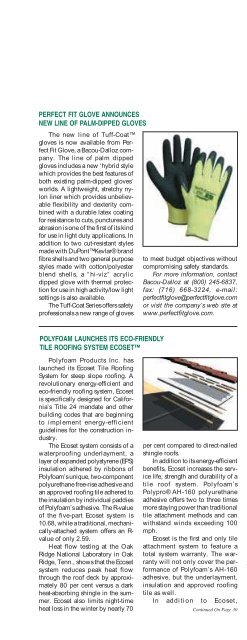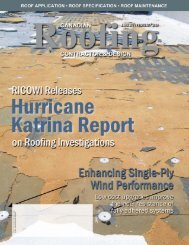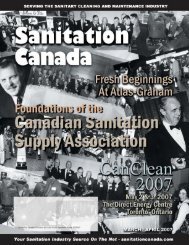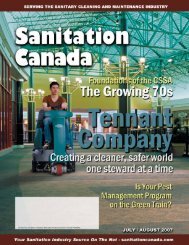here - Perks Publications Inc.
here - Perks Publications Inc.
here - Perks Publications Inc.
Create successful ePaper yourself
Turn your PDF publications into a flip-book with our unique Google optimized e-Paper software.
special feature<br />
Continued From Page 18<br />
PHOTO COURTESY OF DURO-LAST ROOFING INC.<br />
20 Canadian Roofing Contractor & Design - APRIL / MAY 2007<br />
the United Nations Commission on<br />
the Environment and Development,<br />
dates back to 1987. The UN Commission<br />
defined “principles of environmental<br />
sustainable development” as: Development<br />
that meets the needs of the present<br />
without compromising the ability of future<br />
generations to meet their own needs.<br />
The First International Conference<br />
on Sustainable Construction was held<br />
in Tampa, Fla., in 1994. Attendees defined<br />
sustainable construction as: The<br />
creation and maintenance of a health<br />
built environment based on ecologically<br />
sound principles and resource efficiencies.<br />
The definition for sustainable roofing<br />
most experts cite today is the one<br />
used in the proceedings of the Sustainable<br />
Low-Slope Roofing Workshop<br />
held at the Oak Ridge National Laboratory<br />
facility in Oak Ridge, Tenn., in<br />
October 1996. At the workshop, a sustainable<br />
roof was defined as A roof system<br />
that is designed, constructed, maintained,<br />
rehabilitated and demolished with<br />
an emphasis throughout its life cycle on<br />
using natural resources efficiently and<br />
preserving the global environment.<br />
Life Cycle Assessments (LCAs) are<br />
science-based studies designed to measure<br />
the environmental impact of a<br />
product through its entire life cycle.<br />
The objective of an LCA is to examine<br />
and uncover all the important environmental<br />
factors involved in the production,<br />
use and disposal of a product – a<br />
“cradle-to-grave” analysis that yields<br />
what is called an ecoprofile. In the case<br />
of roofing products, some of the important<br />
criteria an LCA examines include:<br />
• Material Extraction Costs: Environmental<br />
impact of obtaining and<br />
transporting raw materials.<br />
• Manufacturing Waste: The<br />
amount of wastewater and solid waste<br />
generated during the manufacture of<br />
the finished roofing product.<br />
• Hazardous Waste: The amount<br />
of toxic emissions resulting from the<br />
extraction of raw materials, manufacture<br />
and transport of the finished product<br />
and installation of the roofing system.<br />
• Embedded Energy: The amount<br />
of energy required to extract, transport,<br />
manufacture, deliver, install, maintain<br />
and discard a roofing product during<br />
its life cycle.<br />
• Recycling and Re-use: The potential<br />
for a used roofing product to be<br />
recycled or re-used in another form.<br />
LCAs are very complex and results<br />
can vary depending on methodology,<br />
underlying assumptions and, unfortunately,<br />
the source of funding. LCAs are<br />
used today primarily as guidelines for<br />
establishing or defining standards, and<br />
in the design phase of product development.<br />
The U.S. Green Building<br />
PHOTO COURTESY OF DURO-LAST ROOFING INC.<br />
Council has formed a task group to<br />
study the feasibility of applying LCA<br />
findings toward practical use in building<br />
and construction. Various other<br />
industry groups have already concluded<br />
that, while LCAs are interesting and<br />
useful as guidelines, they are not likely<br />
to be adopted for practical purposes by<br />
the building and construction industry.<br />
In their Primer on Sustainable Building<br />
Design, the Rocky Mountain Institute<br />
maintains that sustainable roofing<br />
can be accomplished in five different<br />
ways:<br />
• Recycled content in the roofing<br />
product.<br />
• The use of recycled materials,<br />
such as thermoplastics or metal.<br />
• Extended service life.<br />
• More efficient use of energy and<br />
other natural resources.<br />
• The actual renewal of natural resources.<br />
A more thorough, practical guide to<br />
sustainable roofing – The Tenets of<br />
Sustainability – was published by the<br />
International Council for Research and<br />
Innovation in Building Construction<br />
(CIB) in 2000 after five years of com-










